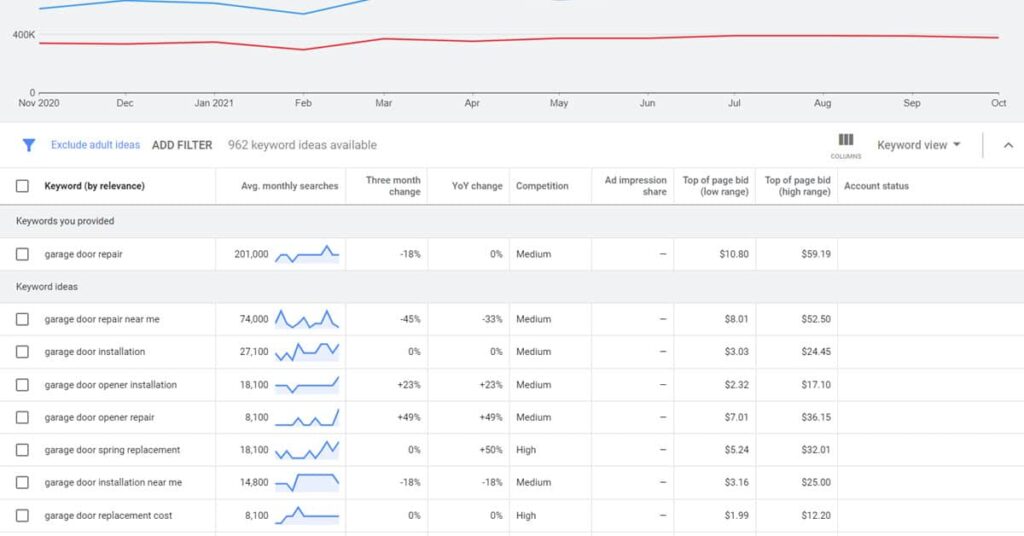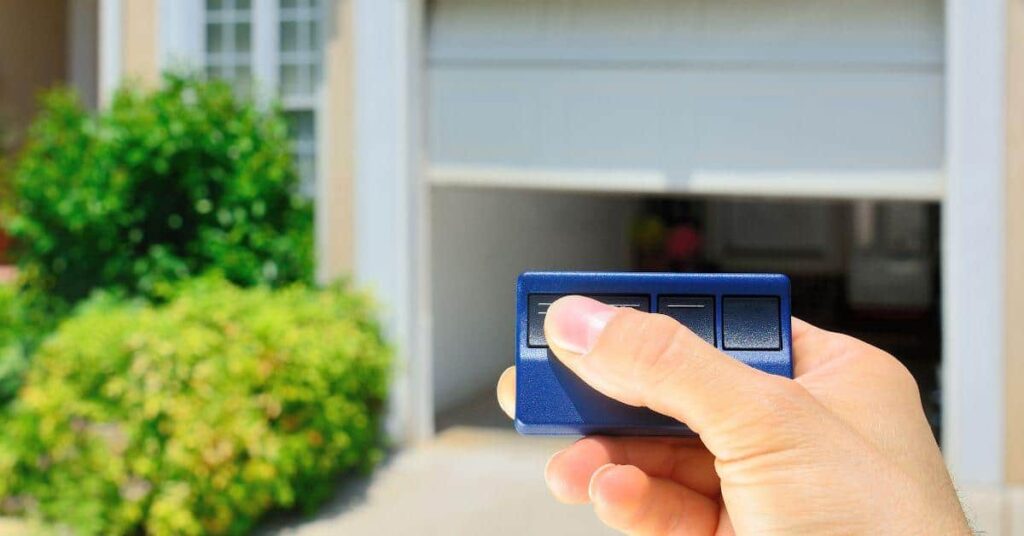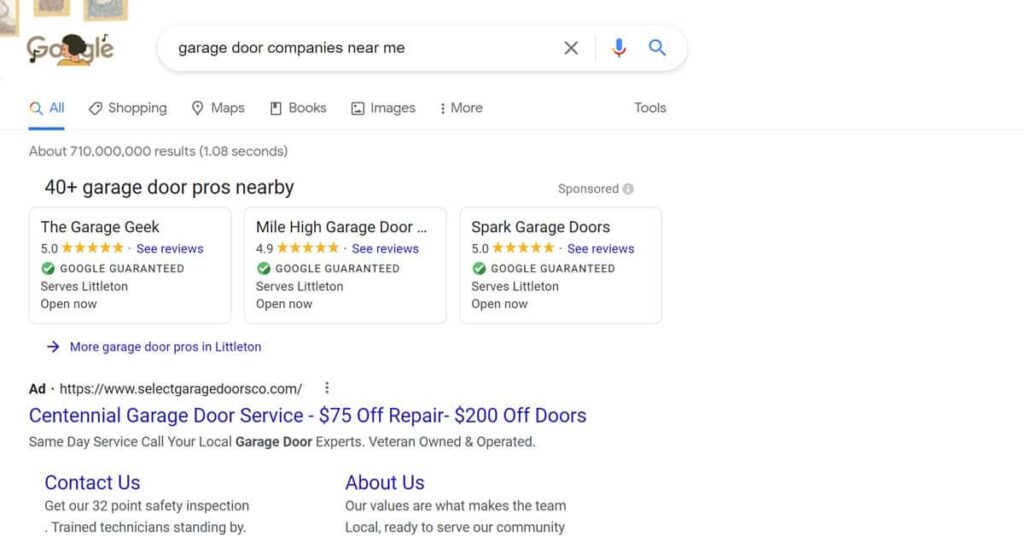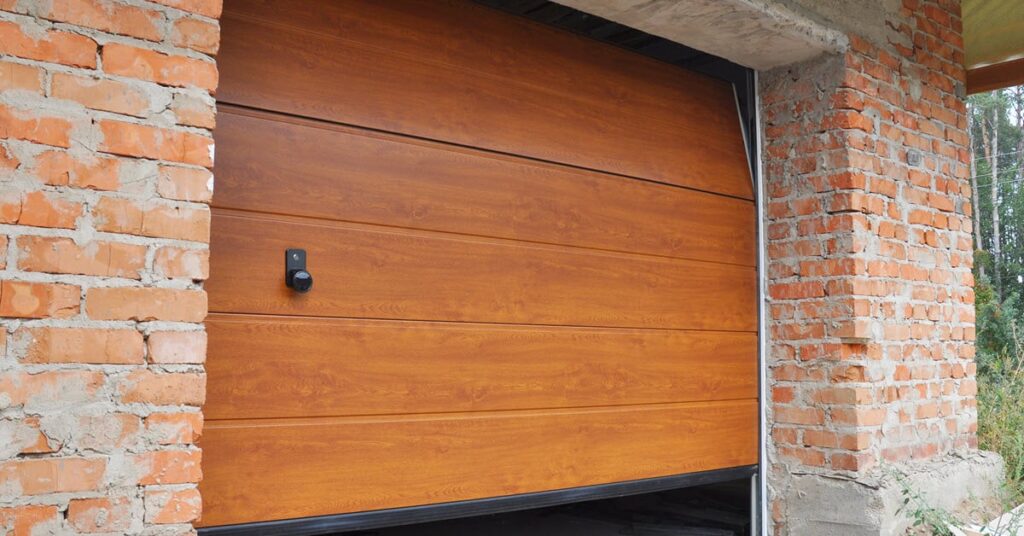Get Garage Door Leads with Google Ads
When you’re looking to generate leads for your garage door business , advertising using Google Ads is one of the first online marketing channels should explore. With Google Ads, your advertising message appears in front of a potential customer at the exact moment that they’re searching for the services that you offer.
Google Ads is the clear leader and your first choice for garage door PPC marketing. PPC stands for “pay-per-click” – we’ll cover exactly what that means in a bit.
Google ads one of the most effective digital marketing tools available for home services providers. In my experience, SEO can provide a much lower cost per lead over time – but I recommend most companies get started with Google Ads to get leads quickly – hopefully at a solid return on your marketing budget. Note that Google Ads can certainly be complex. We’re here to help with marketing services for garage door repair businesses.
Advanced Verification is Required
Note that garage door repair company owners looking to run ads on Google must first pass an advanced verification process. Only garage door businesses and locksmiths have to complete this additional step due to fraudulent practices and fake business listings by some garage door companies – and unethical people pretending to be garage door companies. Fortunately, we can help guide you through that process – please see our article on Google Advanced Verification for Garage Door Companies.
Overview of How Google Ads Generates Garage Door Leads
If a homeowner or commercial business owner is in need of garage door services, one of the first places that they’ll go for help is to Google. They will type in the services that they need – although most homeowners may not know exactly what the issue is unless it is fairly easy to diagnose. They’re much more likely to search for “garage door repair”, “broken garage door spring” or “noisy garage door” as opposed to “garage door cable replacement” or “garage door sprocket issue”.
In the search below, a homeowner in the Denver metro area has searched for “garage door companies near me”.

The search results page for a search on “garage door repair”
As you can see above, there are four sets of results on the Google search results page:
Local Services Ads
Local Services Ads appear at the very top of the search engine results page – (1) in the image above. This is a lead generation service provided by Google.
We recommend that most garage door companies at least experiment with this local service ad offering to see if they get a good return on their investment. Companies are vetted by Google, and you can actually see the Google Guaranteed badge associated with each local services ad above.

The focus of this article is how your garage door company can effectively make use of Google search ads, but for more information on how these Google Local Services Ads work and whether they might be a good fit for you, check out our in-depth article about Garage Door Local Service Ads .
Google Search Ads
Directly beneath the Local Services Ads are the Google Search Ads (formerly known as Google AdWords). These are denoted by (2) – and in purple in the image from the overview of this section.
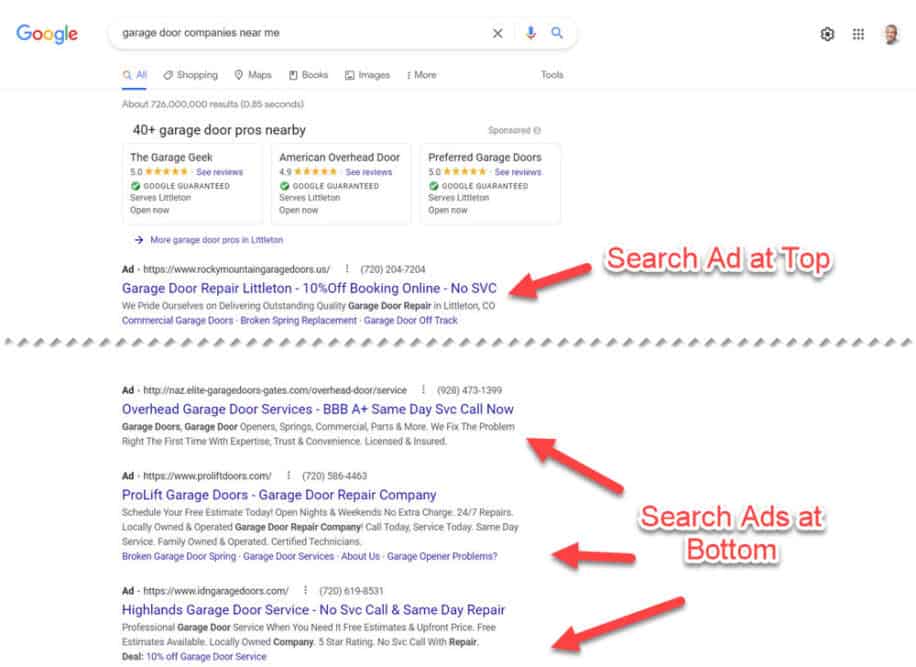
Google Search ads appear at the top and the bottom of the search engine results page (note I had to cut out the results in the middle of the page to display all of the ads together)
You’ll find anywhere from 1-4 search ads at the top of the page. Another paid ad location is at the bottom of the search engine results page. There can be another three or four ads at the bottom.
The searcher will view your ad. You likely won’t be the only garage door contractor with a Google Search ad on the page. You’re going to want to have very strong ad copy to encourage the user to click on your ad.
If they find your message compelling, they’ll click on your ad and be brought to your website. On your website, you’ll have an opportunity to get them to contact you to schedule service.
This is called ppc advertising (pay-per-click) because you pay Google each time a potential customer clicks on on one of your ppc ads.
We’ll be diving into Google Search Ads more in just a moment, but for now, here are two big advantages of Google Search Ads that make them extremely effective garage door marketing tactics when compared to everything else on the search page:
1) You Control the Message
Unlike any other section of the search results page, with ppc for garage door companies using Google, you get to control the title of the ad listing for your small business. You’ll want to make it closely match the user’s search for the best results. If they search for broken garage door spring, the title of your ad should mention that you fix broken garage door springs.
You also can modify the ad description to highlight specials, years of experience, location and more.
Additionally, Google Ads has a lot of features and links to make your ads larger and stand out more.
This differs from other listings on the search results page:
- Local Services Ads have little text and customization.
- Business profile listings are mandatory for effective SEO, BUT – on search results pages are very limited and offer almost identical information for each business.
- Organic Search Results are sometimes pulled from your website content, but Google may rewrite or modify the text from your site within the listing. You don’t completely control what the searcher sees with organic search result listings.
2) You Control the Link
The other great differentiator of Google Ads versus other listing types on the search results page is that you control the exact page where the link goes. If you’re running ads about broken springs, you can send them to your page about broken garage door spring repair (instead of the home page)
The Map Pack (Business Profile Listings)
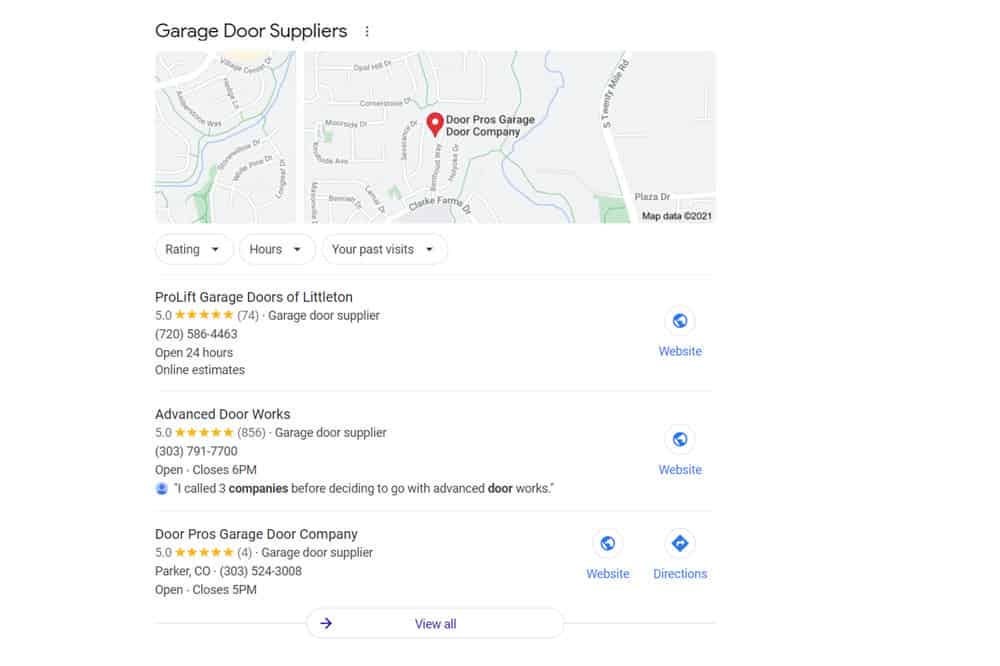
Beneath the search ads is the Google Map Pack. These are the Google Business Profile listings and are in yellow and denoted by (3) in the overview image of this section. Note that Google recently underwent a name change for these listings – they used to be called Google My Business Listings.
Garage door service provider ads may also appear within this map pack if you have location extensions enabled for your ad account – we’ll get more into that later in the article.
The appearance in the map pack is typically determined by the proximity of your garage door business to the person conducting the search. That said, you may increase your chances of appearing in this map pack by fully completing your Business profile and keeping it active.
You definitely want to make sure you completely fill out your business profile. It is a way for you to get free leads from Google. It is especially convenient on mobile as there will be a click to call button on your listing making it super easy for a prospective customer to get in touch.
While the focus of this article is Google search ads, we’ll talk more about Business Profile listings for Garage Door companies in an upcoming article.
Organic Search Listings (SEO / Free)
Finally, towards the bottom of the search results are the organic (free) search listings. These are in position (4) from the image in the overview of this. You can appear high up in these organic listings with a sound search engine optimization (SEO) efforts. In fact, having a good Garage door repair SEO strategy is a must for your business. When someone clicks on these listings and makes contact with you for garage door services, it costs you nothing.
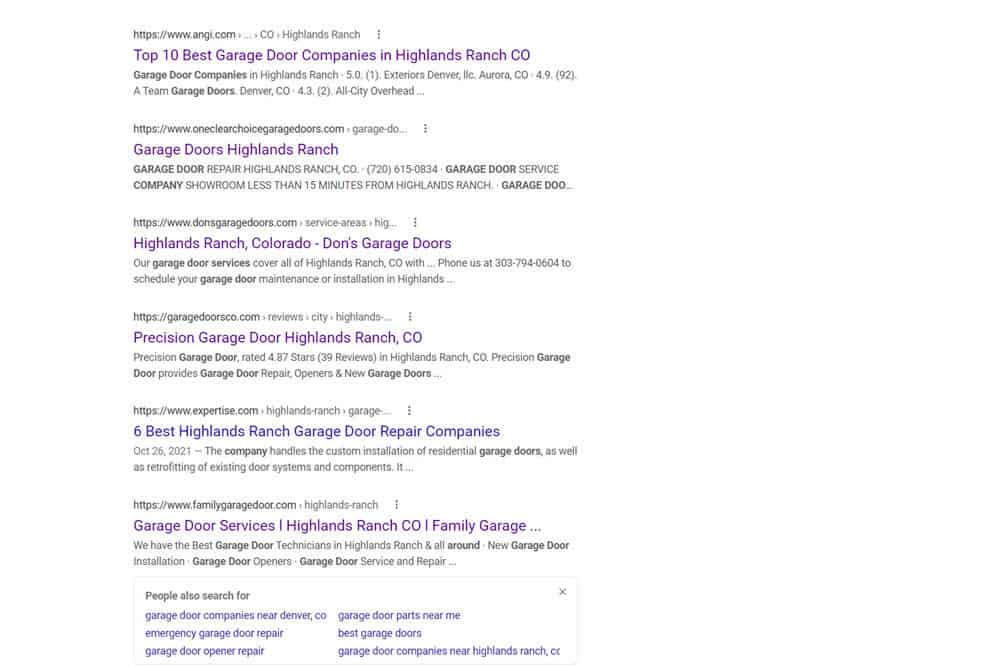
Some of the organic search results for “garage door companies near me”
While these listings are de-emphasized by Google (you have to scroll beneath ads and maps), these organic results are 15 times more likely to get clicked than paid ads according to a SimilarWeb Study. This is impressive considering you generally can’t even see these organic search results unless you scroll way down on the page.
That said, both paid search and SEO are highly recommended digital marketing strategies for garage door services companies. Starting out with paid search and gradually focusing more effort on SEO – or hiring a company to provide you with SEO services – is what I would generally recommend.
Keep an eye out for our upcoming article on SEO for garage door services companies.
The Google Ads Signup Process
Signing up for Google Ads can be a bit confusing as Google will by default try to get you to sign up for services you may not need or want.
Get a Google Account
You need a Google Account to sign up for Google Ads. A Gmail account will do, but in general, signing up for Google services with a domain-based account is recommended.
As an example, if your business name is Bob’s Garage doors and your domain name is bobsgaragedoors.com, set [email protected] as your Google Account. Then use this account to sign up for Google Ads.
ContractorFAQ.com has instructions for signing up for a Google Account with your business email.
Go the Main Google Ads site

If you already have a Google Account, go to ads.google.com and click on “Start Now”
Head over to ads.google.com to get started – but read the text below carefully.
Don’t Sign Up for Smart Campaigns
As part of the signup process, Google will by default guide you into opting into what they call “Google Smart Campaigns”. Smart Campaigns are a more automated way to run ads on Google. Note that there is nothing that explicitly says “Smart Campaigns”. When it comes to ppc for garage door companies, recommend that you skip Smart campaigns.
While it is easier to get started advertising with Smart Campaigns, the campaigns have less flexibility and control for the advertiser. For some garage door services companies, it may be a good fit. We cover smart campaigns for garage door repair companies in an upcoming article.
For now, click on “Switch to expert mode” in order to start setting up our traditional Google search ads campaign.
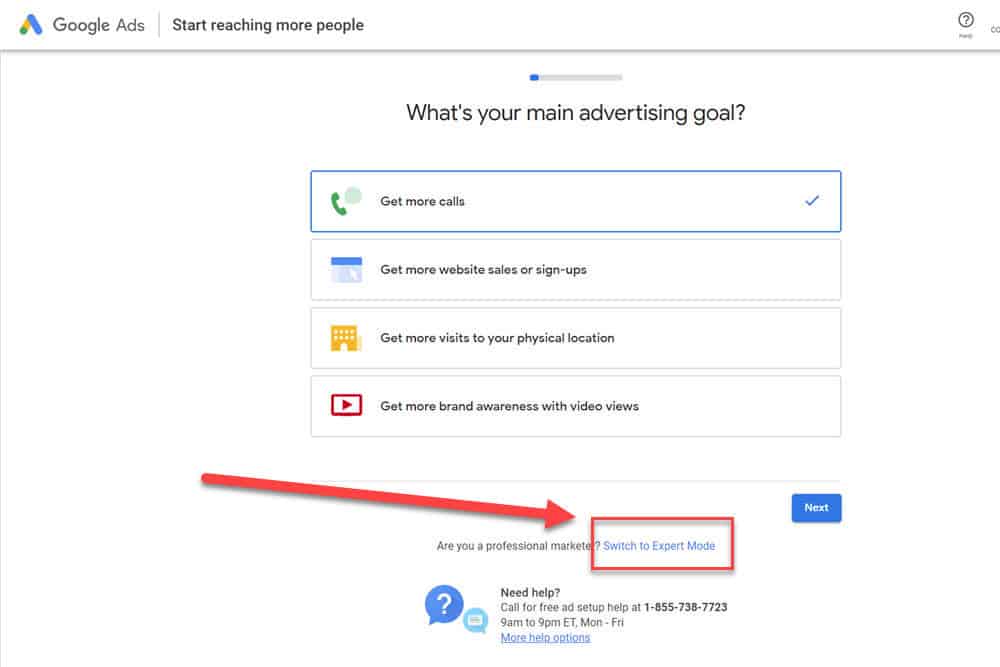
Click on “Switch to Expert Mode” to opt-out of Smart Campaigns and have more control over your Google Ads Experience
Select Campaign Goal – Search Campaigns Only
You will then be taken to the next screen where you’re asked to select a campaign goal. I’m not going to go through each goal type. You can hover over the boxes to learn more.
Unfortunately, each of the goal types recommends multiple campaign types in order to achieve that goal.
For example, although we hover over “Leads”, Google recommends multiple campaign types (Search, Display, Shopping, Video, Smart, Discovery). I have put a transparent “X” over those leads to signify that you don’t want to use those campaign types – at least at the beginning.
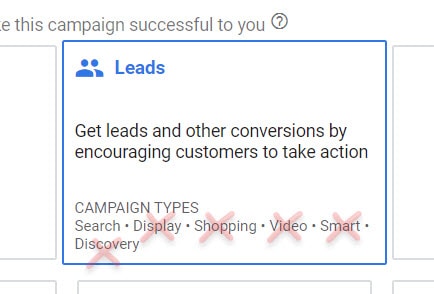
Most of those campaign types wouldn’t be helpful in getting more garage door customers. We only want to run search ad campaigns, so we’ll end up selecting “Create a campaign without a goal’s guidance”.

Select “Create a campaign without a goal’s guidance” from the Google Ads new campaign screen
This will open up some more options as you can see below.
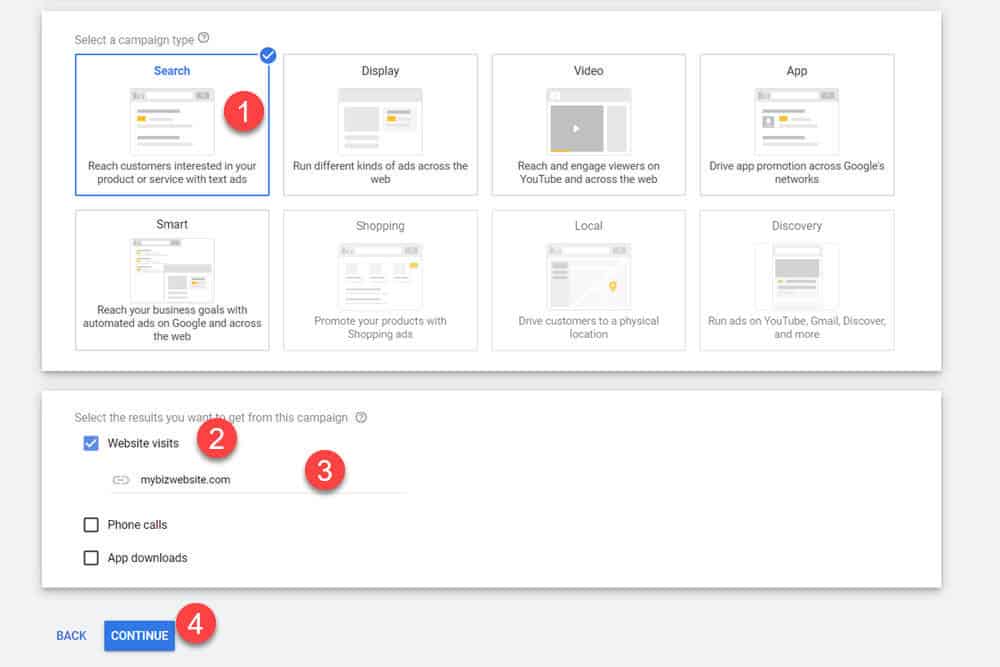
Select “Create a campaign without a goal’s guidance” from the Google Ads new campaign screen
(1) We finally find the search campaign we’ve been looking for – go ahead and select it
(2) You’ll then click on website visits
(3) Enter your website domain
(4) Press continue to keep the process moving
Create Your First Advertising Campaign
On the next page, you will be creating your very first PPC campaign. You will likely have multiple types of campaigns within your ad account.
Campaigns are pretty flexible, and you can break them out however you’d like.
Each campaign has its own unique budget to keep ad spending in check. A campaign also has geographical targeting options (where your ads will be shown).
If you had garage door services with proven high-profit margins, you might put them in the same campaign together. Less lucrative services that you were experimenting with and didn’t want to spend a lot of budget on might go in a different campaign.
Campaigns are pretty flexible. You could have each service as its own campaign to more easily control budget and help with reporting – or – you could set up services as ad groups within campaigns. We’ll get to ad groups in just a bit.
Campaign Name
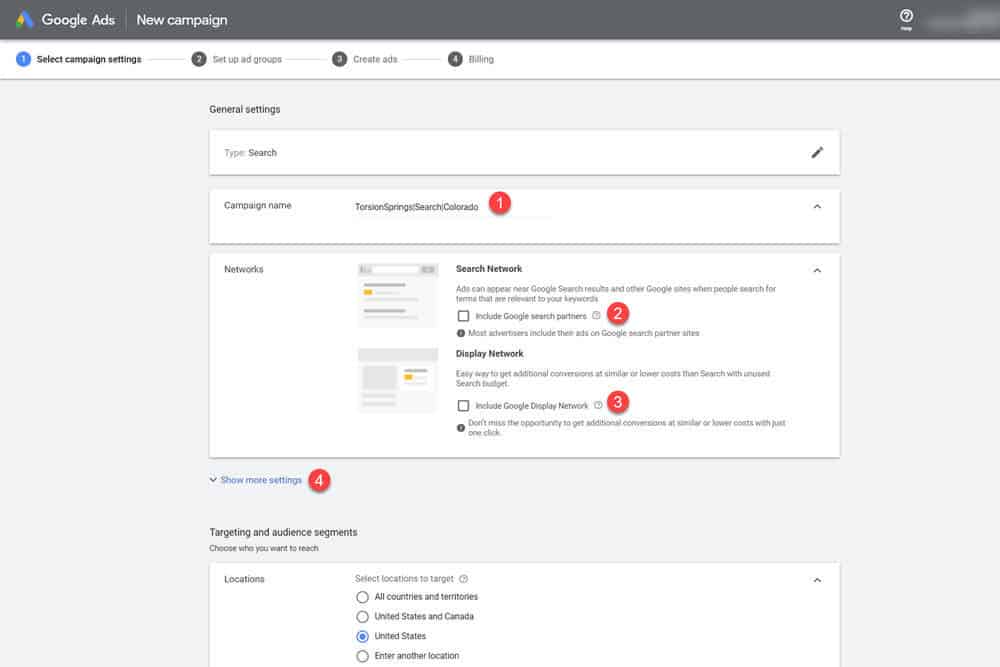
We’re now beginning the Google Ads campaign setup process
We’re going to name our campaign. There are many strategies when naming a campaign – the key is to instantly recognize what the campaign is about when you go into Google Ads.
There isn’t a really “wrong” way to name a campaign, but here is how I do it. As you can see in the screenshot above (1), I named the campaign based on Service (Torsion Springs), Ad Network Type (Search), and location (Colorado).
TorsionSprings|Search|Colorado
Networks
We are only going to be running ads on the search network (2).
Don’t check the box for including your ads on Google Search Partners.
Google Search partners is a network of hundreds of thousands of sites where your ad may appear if someone conducts a search from one of those sites.
I recommend ignoring Google’s warning that most advertisers include their ads on the search partner sites. When putting together any digital marketing campaign, it is always best to know exactly where ads for your garage door repair business are appearing. You can’t get that insight by running ads with search partners.
While I have had some success with search partners in some instances, I always recommend getting your ads to work on Google before trying out search partners.
Uncheck the “Google Display Network”
Google Display Ads are part of Google Ads, and you can run display ads and search ads from the same account – but you definitely shouldn’t, so uncheck the “Include Google Display Network” (3).
Display ads show text or banner images on websites that are likely completely unrelated to garage doors. As an example, your favorite sports site is most likely running display ads. Advertisers using display ads are generally doing so for name recognition (branding) and not direct sales.
When setting up ppc for garage door companies, you’ll want to skip using display ads.The urgent nature of garage door repair requests makes display ads a poor fit. When people need your services, it is usually an emergency. They’ll do a search and start contacting whoever they believe can fix their problem – rather than rely on a display ad they may vaguely remember seeing a few weeks ago.
Ad Schedule
To access the ad schedule, you’ll have to expand the “show more settings” option (4). You can enter the hours to run your ads in 15 minutes here based on your schedule. Shown below is a sample ad schedule for an ad campaign that is already live.

When should you run ads?
You’ll have to figure out what works best for your garage door business. But due to the emergency nature of garage door services, I would recommend only running ads when:
- You’re available to answer the phone
- You (or one of your techs) can make it out to service the prospect’s garage door within a few hours after the call
So, I would consider running ads only during part of the hours that you’re actually open.
As an example, if you close at 5 for the day and don’t ever want to work past 5, you may wish to stop running ads at 3 or 4 to ensure that you can service all emergencies the same day.
Some homeowners and businesses with garage door issues will be patient enough to schedule a day or two out – others want it fixed right now. After a while, you should get a feel for what ad schedule works best for you.
Locations
In this section, you’re going to only target areas where you want your target customers to see your ads. These locations should obviously be within your service area – but it doesn’t necessarily have to include your entire service area.
Make the following selections for Location settings:
- Presence: People in or regularly in your targeted location (7)
- Presence: People in your excluded locations (8)
- Click Enter another location (6)
- Click on advanced search (9)
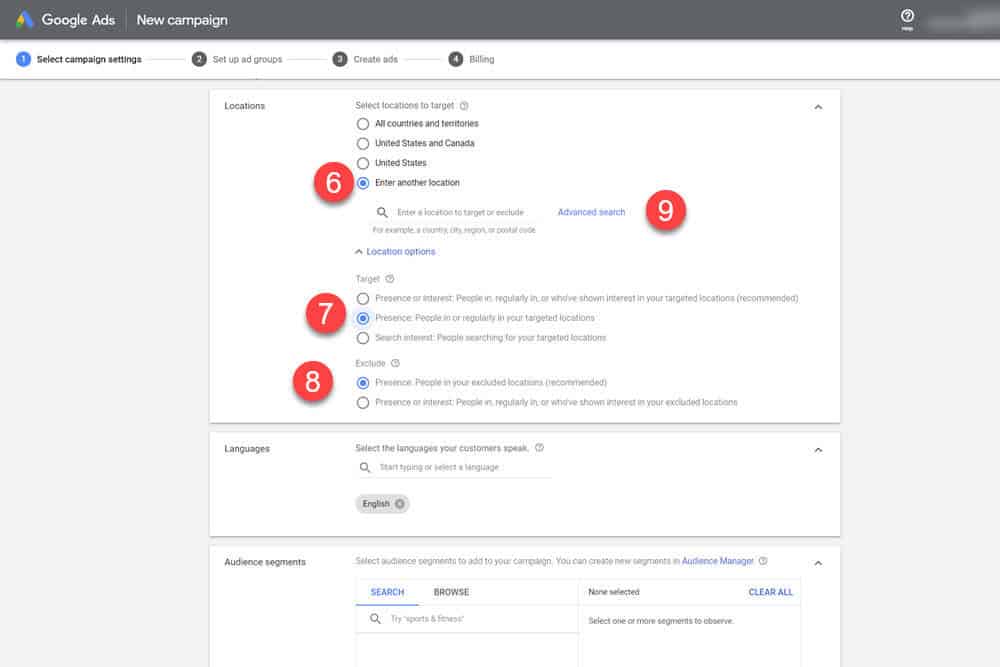
Click the options as shown above and click on “Advanced Search” to target your ideal customers down to the zip code level
A window will pop up which allows you to target (or exclude) areas for your ad to be displayed. Google allows very flexible geographical targeting options. As you can see, you can target by zip code, by city or region, and you can even target a radius around a certain point. This radius targeting can be helpful if you want to target prospects that are only within a certain distance from your main office.
We’ve targeted a zip code (80401), a City (Denver), and a radius (5 miles around Westminster). We’ve also excluded a region (Arvada) as you can see in red.
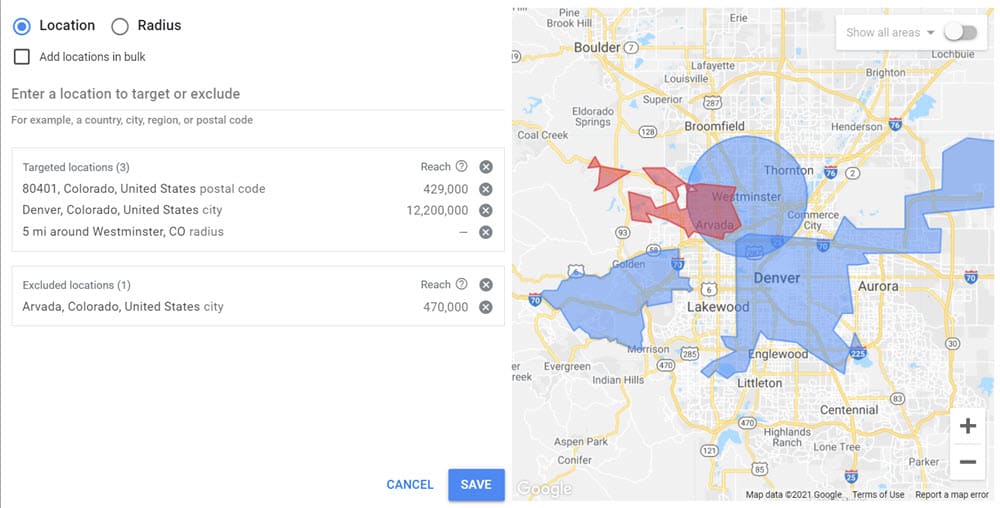
Excluding regions allows is helpful to prevent your ads from showing within larger regions that you do want your ad to appear. As an example, you may wish to target a city, but exclude a zip code which only has on-street parking (dense urban areas where there are few homeowners with garages).
Click “Save” when you’re done targeting
Languages and Audience Segments
The proper language for your location should probably show by default, change it if that isn’t the case. Audience segments is a more advanced topic, so we’re just going to skip over this section.
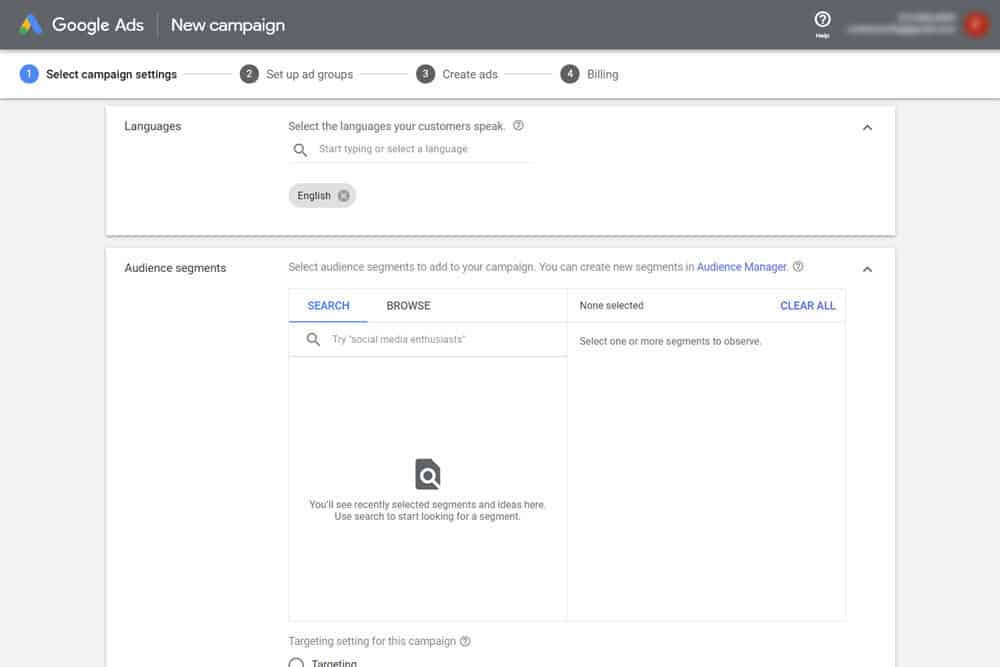
Language and Audience Segment Options
Budget
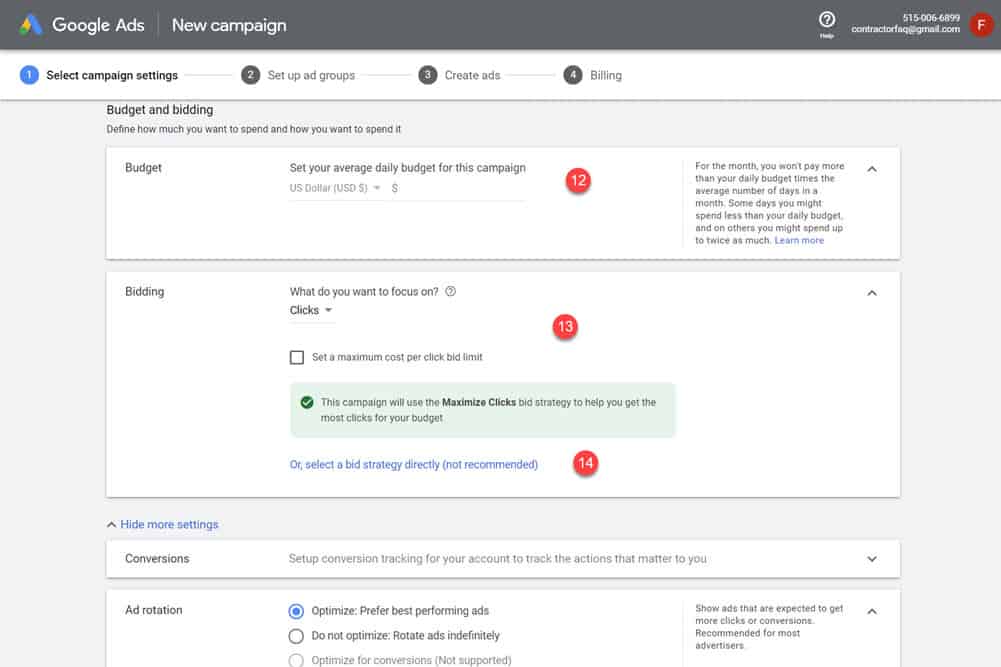
For budget (12), set your average daily budget for the month. Google Ads may exceed your daily budget on a given day but won’t exceed your average daily budget for the month.
Bidding
Google has advanced automated bidding options (13) to help advertisers meet their goals. By default, Google uses “Maximize Clicks” to help you get as many clicks as possible within your budget.
To be highly effective with these automated bidding strategies, Google needs a lot of data (ad impressions and clicks). I find that garage door services companies don’t get an optimal level of volume for Google’s bidding to be effective.
While it is more work to manage, I like to click on “Select a bid strategy directly”, and I then select “Manual CPC”. This requires you to set the bids at the campaign, ad group, or even keyword level for your ad campaigns. You’ll have to monitor your campaign closely and adjust bids as needed.

While not recommended by Google, I like to select Manual CPC as a bidding strategy for relatively low volume ad campaigns – including Garage door services.
Conversions
You will definitely want to set up conversion tracking (16) by clicking the link in the conversions section. With conversion tracking, you will know what keywords and campaigns are resulting in customers reaching out for your garage door services. You can then analyze the ad costs that led to these conversions and adjust your bids accordingly (perhaps by bidding more if you’re getting a great margin).

Set up conversions, take default rotation option, and click on (18) to create ad extensions
For home service companies like garage doors, you’ll want to set up conversion tracking on your website for both phone calls and form leads.
Form lead conversion tracking
This requires installing a bit of code (provided by Google ads) on your website. You can install this code manually or use Google Tag Manager.
Phone lead conversion tracking
Google Ads has built-in phone call conversion tracking, but the number Google displays as part of your ad campaign may change periodically.
As a result, I purchase phone numbers from third-party call providers for my home service contractors.
That way the phone number that prospect sees from a Google Ad never changes and that number will always forward to the main phone number – even if they call the same number weeks or months later.
A third-party call provider also allows you to set up unique phone numbers from other marketing channels for your Garage door advertising ( Microsoft Advertising , LinkedIn Ads , Radio, Facebook, Billboards,…)
This adds an extra step, but I find the data to be worth it. Going this route will require getting a piece of code from the third-party call service, and integrating everything with Google Analytics.
Ad Rotation
Keep this setting (17) to optimize. I prefer to not optimize ad rotation, but it is quite a bit of extra work.
Google is moving away from static ads (expanded text ads) in 2022 and moving to responsive text ads. I suspect this ad rotation setting will go away as a result, so it is probably best to just keep the default setting for now.
Ad Extensions
You’ll want to at the very least add sitelink extensions, call extensions, and callout extensions.
Sitelink Extensions
You should definitely include site link extensions within your ads. Sitelink extensions can make your ads larger. Ads that take up more real estate on the search results page are more likely to get clicks.
The links in site link extensions will link directly to pages (usually services pages) on your garage door company website. So you’ll want to make sure you have a fully developed website prior to attempting to add these extensions.
You should add sitelinks for each service that you’d like to promote. As a garage door company owner, you should strongly consider adding sitelinks for each of the services pages that you have on your site. Examples sitelinks you may wish to create are shown here:
- Broken Springs
- Garage Door Parts
- Garage Door Opener Issues
- Garage Door Installation
- General Garage Door Repair
- Garage Door Track Problems
- Noisy Garage Doors
- Garage Door Rollers
- Commercial Garage Doors
- Garage Door Cable Problems
- Emergency Garage Door Replacement
Google is constantly changing the way that sitelinks are displayed, but a couple of examples are shown below.

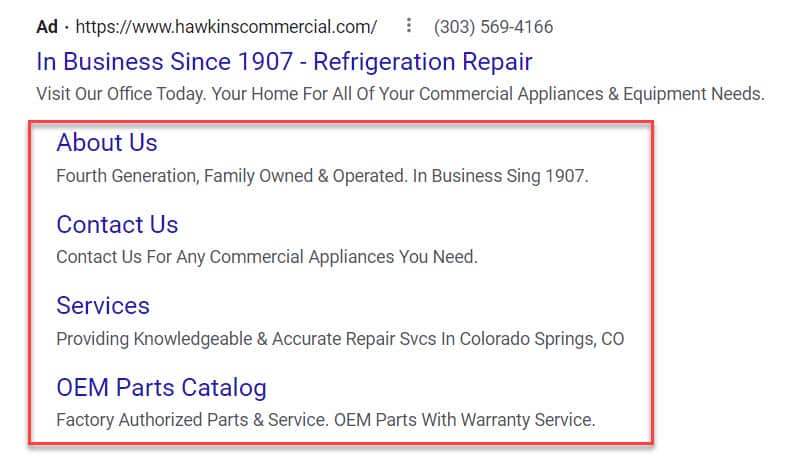
Below is a sample of how you may wish to fill out the sitelink extensions for your garage door business. Here, we’re setting up sitelink extensions for Broken Springs and Noisy Garage Doors.

Setting up sitelink extensions for your garage door ads.
Sitelink Text (20) – this is the clickable part of the sitelink. When clicked, it will take them to the Final URL (23). When sitelink extensions are shown the description text (21), (22) may or may not be shown.
Callout Extensions
Google also allows you to add up to 10 callout extensions that may show with your ad on searches garage door-related services. Callout extensions are separated by dots and aren’t clickable unlike site extensions.
While I’m seeing less callout extensions with ads (sitelinks tend to dominate), you’ll still want to add callout extensions to your ads in case Google decides to show them.
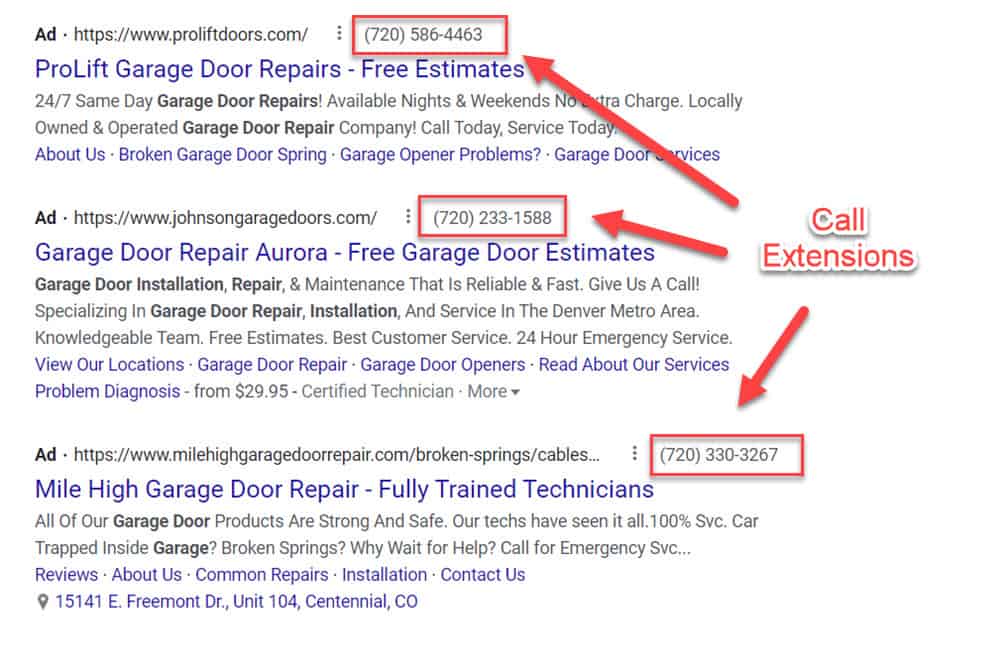
Callout Extension setup in Google Ads
You can mention the same sort of service related content that you do for sitelinks, or you can use items that may impress garage door customers without them needing to click to understand the benefit that you’re providing.
Examples for callout extensions are shown in the screenshot below – this screenshot is from the Google Ads guide on callout extensions. Specific benefits that separate you from your competitors work best as callout extensions.

Call Extensions
Adding a phone number can help customers make contact more easily and is highly recommended. Using a call extension is the ONLY way to enter your phone number as part of an ad. Entering your phone number anywhere else in your ad is likely to result in your ad getting disapproved.
You can use your main phone number or a number from a third-party phone provider that will forward to your main number (although it is a bit challenging to get third-party phone numbers verified by Google for use as call extensions).
Call extensions will appear as a visible phone number on desktop and will be click to call on mobile.
You can enter your call extension information and scheduling as shown below (25).

Call extensions appearing in Google Ads

Ad Groups
Now that your first campaign is established, it is time to set up Ad Groups. Each campaign can have one or more ad groups.
Ad groups should be “themes” of related keywords. In the case of garage door companies, it would be logical to have your ad groups correspond to garage door services that you provide.
Ad Group Type
For your garage door business, you’ll want to choose standard for your ad group type (1) in the screenshot below. With dynamic ad groups, Google will create ad headlines for you automatically based on the content of your website.
I trust myself to write ads that are relevant to my customers as opposed to letting Google’s algorithms write my ads via the dynamic ad group setting. You should know what your typical garage door customer values and write your own ad as opposed to letting Google create an ad for you.
Default Bid
Bidding can be done at the ad group or the keyword level (and we’ll be discussing keywords momentarily). If you don’t have individual keyword bids within your ad groups, this default bid will be used to help determine whether or not your ad is shown when someone searches for a keyword relevant to the services that you provide.
It is a bit tricky to find the perfect bid for ad groups and keywords. Using the keyword tools mentioned below may help with you identifying potential bids for keywords that you’d like to use.
Keywords
Next, you need to enter keywords that make sense for this particular ad group.
Note that keywords are a very in-depth topic. I take a deep dive into this in my upcoming post about Google Ads Keywords for garage door companies.
What follows here is a brief overview.
Finding Keywords
You can get keywords from multiple different sources, including:
- Google Suggested Keywords
- Your Own Business Experience
- Keyword Discovery Tools
Google Suggested Keywords
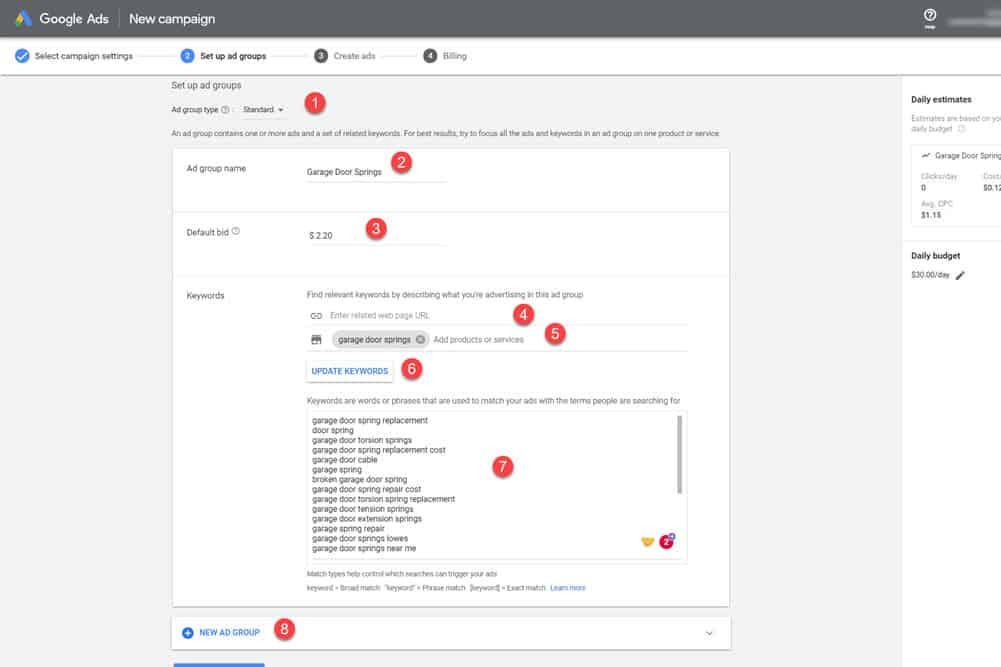
Google will have keywords that you can use as suggestions. You can either enter your landing page url (4) or enter a keyword (5), and Google will come up with recommended keywords for you to bid on.
Once you enter a URL or seed keywords, click on “Update Keywords” (6) to get your list of suggested keywords (7).
I would recommend going through this list to find keywords that you would like your ad to show when someone searches for that keyword. You can keep adding suggested keywords by adding more seed keywords (5). You can also add relevant keywords directly to the list. Remove keywords that aren’t relevant or add them as negative keywords (explained below).
Your Own Business Experience
Try to avoid keywords associated with brand names, technologies, or techniques. Using keywords associated with industry-related terminology of repairing garage doors probably won’t work.
Instead, explore keywords based on what your customers say to you when they call you for your services. It will most likely be a very top-level diagnosis – or a description of the problem. Keywords from those phone calls would likely make ideal keywords for your garage services campaigns.
Keyword Discovery Tools
There are many keyword discovery tools available that you can use. Two that I use are Mangools KWFinder.
Keyword Match Types
There are three distinct match types available in Google Ads. I would avoid broad match keywords and stick with phrase match or exact match as much as possible.
Broad Match Keyword = garage door cable
Google will show ads that relate to your broad match keyword – but Google may take a very broad interpretation of what is related. Your ad might trigger for searches about painting garages or setting up cable in your garage. You can never be certain what Google’s algorithm will do if it isn’t reined in.
Phrase Match = “garage door cable”
Google will show ads that include the meaning of your keyword. There is still some wiggle room for Google’s algorithm and your ad may show for less than optimal searches.
Exact Match = [garage door cable]
Google will show ads having the same meaning or intent of the keyword. While not truly an exact match, it is as close as you can get with Google’s match types.
Negative Keywords = -lowes
Negative keywords are another match type, but when you add negative keywords, your ads won’t show for searches containing that keyword.
Negative keywords have a minus sign in front of them, and as you can see above, I chose “Lowes” as a negative keyword – even though it was provided as a suggested keyword by Google.
The reason is, if someone is looking for garage door parts at Lowes, they are likely a do-it-yourselfer and probably wouldn’t make a very good customer.
Once you’ve added your keywords, go ahead and add another service by clicking on New Ad Group (8). When you’re done click the “Save and Continue” button (not pictured) and then you can create ads.
Due to the very liberal interpretation of match types, having great negative keywords is a must. Check out our article on Negative Keywords for Garage door companies for more details.
Creating Google Ads
On the next page, you’ll be creating ads for each of the ad groups that you created in the previous step.
You’ll create your ad on the left hand side, and an ad preview on a mobile device is shown on the right hand side.
Each ad group will have its own responsive search ad. Shown below is a sample of how you would set up an ad for Garage Door Springs.
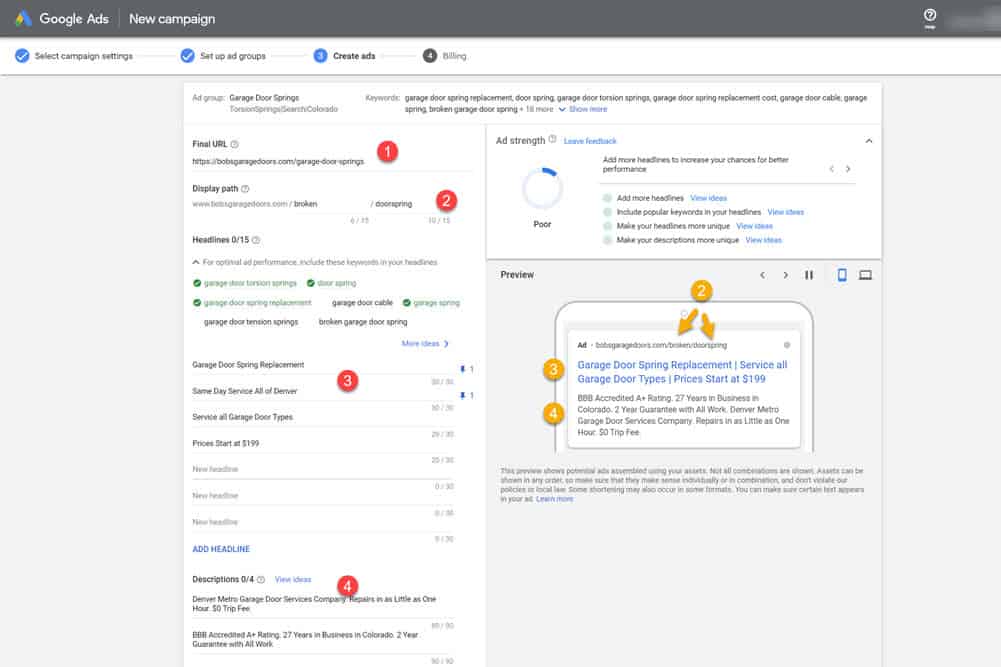
Final URL (1)
This ad group is about garage door springs, so whenever someone clicks on our ad, we will take them to the garage door spring ad on the main website.
Display Path (2)
The display path can be any keywords that you’d like to add to the end of the Final URL. This won’t affect where the visitor is taken, so you can use any relevant keywords that you want here. You can see how the display path appears to the visitor in the preview pane off to the left (yellow 2).
Headlines (3)
You can enter up to 15 headlines as part of your ad. Google will show up to 3 headlines in an ad when seomeon searches for your services. Google will mix and match headlines to try to automatically find the best performing headlines for your ad group. Off to the right in the preview pane, you can see how someone searching for your services may see your headlines in an ad.
Note that there is also something called “pinning” for both ads and descriptions. You can see the blue pin with a “1” next to the first two headlines.
Since Google mixes and matches your headlines, there may be instances where you only want certain headlines to appear in either position one, two, or three. Pinning allows you to accomplish this.
Descriptions (4)
Descriptions allow you to add detail and context to your headlines as you get up to 90 characters to work with. You can pin descriptions just like you pin headlines.
When you’re done adding all the ads for all of your ad groups, you can proceed to the next step, which is billing.
Billing
You’ll enter your payment info on the next page before you can start running ads.
Once your Billing information has been established, you’ll have the opportunity to examine your campaigns and make any adjustments.
Frequently Asked Questions
Can I Run Google Ads by Myself?
PPC Advertising with Google can certainly be somewhat complex if you don’t have a marketing background and if you’re not technologically adept.
You may also wish to check out Google Smart Campaigns. It is a less complex offering of PPC advertising that is very easy to set up and start running ads relatively quickly.
A final option is to consider outsourcing to a garage door repair PPC agency. Many marketing agencies offer PPC management for garage door companies as part of their overall digital marketing services.
Where will my ad appear?
You are never guaranteed a specific ad position with Google Ads. Google determines ad positions based on something called Ad Rank. Ad rank changes each time someone conducts a search (it isn’t a fixed number) but is based on:
- The clickthrough rate of your ad
- Relevance of your ad to the current search
- Relevance of your ad extensions
- How much you’re bidding on the keyword that triggered your ad
- The quality of competitor ad campaigns
How Effective are PPC Ads for Garage Door Lead Generation?
Garage door marketing with Google search ads can be extremely effective. It allows you to get results pretty quickly. With properly structured ad campaigns, you can hopefully achieve a positive ROI with search engine advertising.
Search engine optimization is generally a better long term strategy than search ads, but it does take quite a bit of time (many months) for SEO efforts to start showing positive results.
Both methods are superior to efforts like social media marketing. Due to the urgent nature of many garage door requests, most of your target clients aren’t looking on Twitter or Facebook for garage door repairs.
